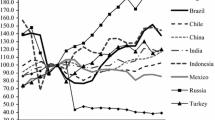Abstract
This study utilizes a recently developed measure of one nation’s competitive exposure to other nations on its export sales to analyze the competitive exposure facing West Africa nations on sales to the United States from 1996 to 2006. The methodology extends previous research by accounting both for similarity in export profiles across nations and for the absolute size of export sales by each nation. We identify changes over time in the importance of different world regions as competitors to West Africa nations, and we highlight the product groups most responsible for West Africa’s competitive exposure to other world regions on sales in the United States.
Similar content being viewed by others
Notes
Benin, Burkina Faso, Cape Verde, Côte D’Ivoire, Gambia, Ghana, Guinea, Guinea Bissau, Liberia, Mali, Niger, Nigeria, Senegal, Sierra Leone, Togo.
Krugman (1991) defines a similar measure \( {\text{SPEC}} = \sum {{{^{\text{n}}}_{{\text{i}} = 1}}\left| {{{\text{a}}_{\text{i}}} - {{\text{b}}_{\text{i}}}} \right|} \) with variables as defined for the F-K export similarity index. See Kim (1999), and Clark and WinCoop (2001) for applications using SPEC.
Complete decompositions of China MOM values showing % contributions by product group for all products contributing to the MOM value are available upon request from authors.
Calculating the fraction of the Latin American MOM value attributable to each product group also was done for those ECOWAS nations with large Latin American MOM values. These results are available from the authors upon request. Results are not presented here due to space constraints.
References
Adams, F. G., Gangnes, B., & Shachmurove, Y. (2004). Why is China so competitive? Measuring and explaining China’s competitiveness. SMU Economics and Statistics Working Paper Series Paper No. 07-2004.
Ahearne, A., Fernald, J., Loungani, P., & Schindler, J. (2003). China and emerging Asia: Comrades or competitors? International Finance Discussion Paper 789, Board of Governors of the Federal Reserves System.
Aldaz-Carroll, E., Yagci, F., & Hinkle, L. (2004). Salient features of trade performance in Eastern and Southern Africa. Africa Region Working Paper Series No. 76. World Bank.
Balassa, B. (1965). Trade liberalization and revealed comparative advantage. The Manchester School of Economic and Social Studies, 33, 99–123.
Brenton, P., Hoppe M., & Newfarmer, R. (2008). Economic partnership agreements and the export competitiveness of Africa. World Bank Policy Research Paper No. 4627.
Cerra, V., Rivera, S., & Saxena, S. C. (2005). Crouching tiger, hidden dragon: What are the consequences of China’s WTO entry for India’s trade? International Monetary Fund Working Paper No. WP/05/101.
Chauvin, S., & Gaulier, G. (2002). Regional trade integration in Southern Africa. CEPII Working Paper No. 2002-12.
Clark, T. E., & WinCoop, E. V. (2001). Borders and business cycles. Journal of International Economics, 55, 59–85.
Devlin, R., Estevadeordal, A., & Rodriguez-Clare A. (2006). The emergence of China: Opportunities and Challenges for Latin American and the Caribbean. Inter-American Development Bank, Washington D.C.
Finger, J. M., & Kreinin, M. E. (1979). A measure of export similarity and its possible uses. Economic Journal, 89, 905–912.
Havrila, I., & Gunawardana, P. (2003). Analyzing comparative advantage and competitiveness: an application to Australia’s textile and clothing industries. Australian Economic Papers, 42(1), 103–117.
Hernandez-Cata, E., Schwab, K., & Lopez-Claros, A. (2004). The Africa competitiveness report 2004. World Economic Forum.
Kim, S. (1999). Expansion of markets and geographic distribution of economic activities: the trends in U.S. regional manufacturing structure, 1860–1987. Quarterly Journal of Economics, 110, 881–908.
Krugman, P. (1991). Increasing returns and economic geography. Journal of Political Economy, 99, 483–499.
Lee, S. C. (2003). Patterns of Canada’s revealed comparative advantage in the United States. University of Regina Department of Economics Discussion Paper Number 104.
Plunkett, D. (1999). Implications for Africa of initiatives by the WTO, European Union, and U.S. African Economic Policy Discussion Paper No. 21. Associates for International Resources and Development.
Sawchuk, G., & Yerger, D. (2006a). With whom does Canada compete in the US marketplace? Consequences of China’s export growth and shifting US import-market shares. Policy Research Initiative Working Paper Series 014, Government of Canada.
Sawchuk, G., & Yerger, D. (2006b). With whom does Canada compete at home? How China is impacting Canadian businesses in the Canadian marketplace. Policy Research Initiative Working Paper Series 027, Government of Canada.
Sawchuk, G., & Yerger, D. (2007). With whom do Canada’s provinces compete at home? How China is impacting provincial marketplaces. Policy Research Initiative Working Paper Series 033, Government of Canada.
Yerger, D., & Sawchuk, G. (2008). Assessing shifts in Canada’s competitive exposure in its home markets: how much does China matter? Competitiveness Review, 18(3), 275–286.
Author information
Authors and Affiliations
Corresponding author
Rights and permissions
About this article
Cite this article
Sissoko, Y., Yerger, D.B. West Africa’s Evolving Competitive Exposure in U.S. Import Markets. Int Adv Econ Res 16, 11–23 (2010). https://doi.org/10.1007/s11294-009-9248-1
Published:
Issue Date:
DOI: https://doi.org/10.1007/s11294-009-9248-1




